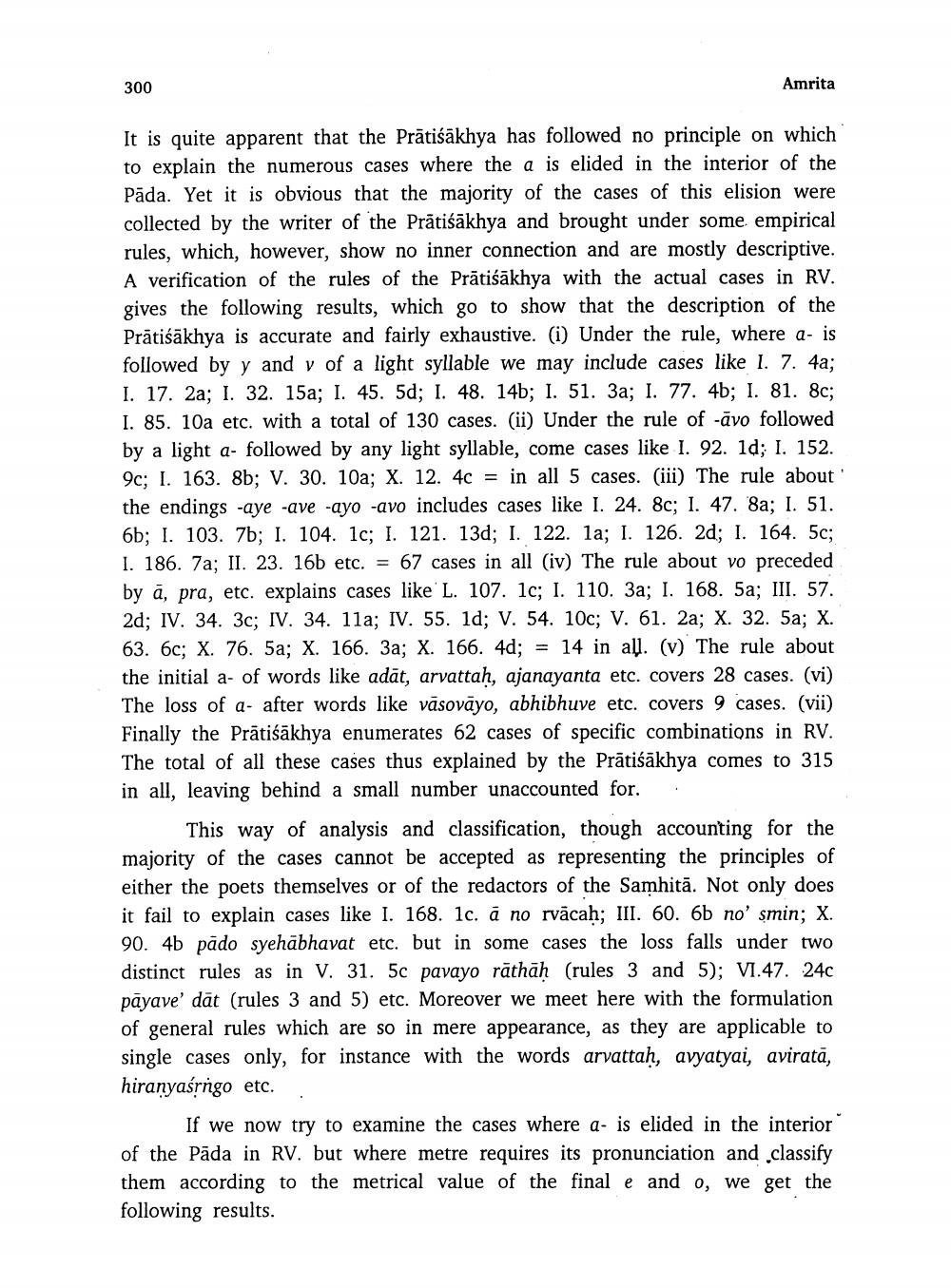________________
300
Amrita
It is quite apparent that the Prātiśākhya has followed no principle on which to explain the numerous cases where the a is elided in the interior of the Pāda. Yet it is obvious that the majority of the cases of this elision were collected by the writer of the Prātiśākhya and brought under some empirical rules, which, however, show no inner connection and are mostly descriptive. A verification of the rules of the Prātiśākhya with the actual cases in RV. gives the following results, which go to show that the description of the Prātiśākhya is accurate and fairly exhaustive. (i) Under the rule, where a- is followed by y and v of a light syllable we may include cases like I. 7. 4a; I. 17. 2a; I. 32. 15a; I. 45. 5d; I. 48. 14b; I. 51. 3a; I. 77. 4b; I. 81. 8c; I. 85. 10a etc. with a total of 130 cases. (ii) Under the rule of -avo followed by a light a- followed by any light syllable, come cases like I. 92. 1d; I. 9c; I. 163. 8b; V. 30. 10a; X. 12. 4c = in all 5 cases. (iii) The rule about the endings -aye -ave -ayo -avo includes cases like I. 24. 8c; I. 47. 8a; I. 51. 6b; I. 103. 7b; I. 104. 1c; I. 121. 13d; I. 122. la; I. 126. 2d; I. 164. 5c; I. 186. 7a; II. 23. 16b etc. = 67 cases in all (iv) The rule about vo preceded by a, pra, etc. explains cases like L. 107. 1c; I. 110. 3a; I. 168. 5a; III. 57. 2d; IV. 34. 3c; IV. 34. 11a; IV. 55. 1d; V. 54. 10c; V. 61. 2a; X. 32. 5a; X. 63. 6c; X. 76. 5a; X. 166. 3a; X. 166. 4d; = 14 in all. (v) The rule about the initial a- of words like adāt, arvattah, ajanayanta etc. covers 28 cases. (vi) The loss of a- after words like vāsovāyo, abhibhuve etc. covers 9 cases. (vii) Finally the Prātiśākhya enumerates 62 cases of specific combinations in RV. The total of all these cases thus explained by the Prātiśākhya comes to 315 in all, leaving behind a small number unaccounted for. .
This way of analysis and classification, though accounting for the majority of the cases cannot be accepted as representing the principles of either the poets themselves or of the redactors of the Samhitā. Not only does it fail to explain cases like I. 168. 1c. ā no rvācah; III. 60. 6b no' smin; X. 90. 4b pădo syehābhavat etc. but in some cases the loss falls under two distinct rules as in V. 31. 5c pavayo rāthāh (rules 3 and 5); VI.47. 24c payave' dāt (rules 3 and 5) etc. Moreover we meet here with the formulation of general rules which are so in mere appearance, as they are applicable to single cases only, for instance with the words arvattah, avyatyai, aviratā, hiranyaśrngo etc.
If we now try to examine the cases where a- is elided in the interior of the Pāda in RV. but where metre requires its pronunciation and classify them according to the metrical value of the finale and o, we get the following results.




